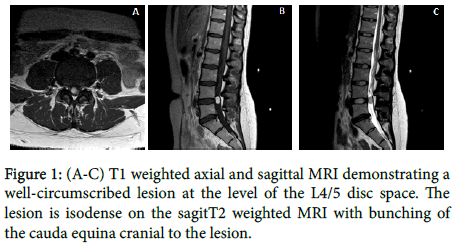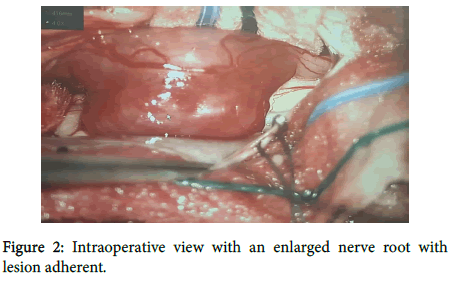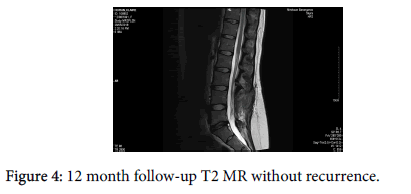Capillary Hemangioma of the Cauda Equina with High Mitotic Activity: Case Report and Review of the Literature
Received: 19-Dec-2018 / Accepted Date: 02-Jan-2019 / Published Date: 09-Jan-2019 DOI: 10.4172/2476-2024.1000150
Abstract
Background: Capillary hemangiomas of the skin and soft tissue are a common entity, while capillary hemangiomas of the central nervous system are an extremely rare pathology. There are less than 20 published cases of intradural lesions involving the cauda equina.
Case presentation: Herein, we describe a young patient with a capillary hemangioma of the cauda equina that underwent successful surgical resection.
Conclusion: Natural history and post-operative follow-up for patients with spinal intradural capillary hemangioma is uncertain. This is the sole case to have not recurred at 12 months which underwent gross total resection and had a high proliferative index.
Keywords: Capillary hemangioma; Cauda equina; High mitotic activity
Introduction
We present a case of a intradural capillary hemangioma of the cauda equina presenting as longstanding right lower limb radicular pain in a 27 year old female. The natural history of intradermal capillary hemangiomas is unclear, however hemorrhage can lead to acute cauda equine syndrome, and thus emergent surgical resection is recommended.
Lesions within the spinal canal account for 15% of all central nervous system tumors. Furthermore, 7% of intradural lesions are of vascular origin [1-3]. Spinal vascular tumors are classified as arteriovenous malformations, venous malformations, capillary telangiectasias, cavernous angiomas, and capillary hemangiomas [4,5]. Capillary hemangiomas are histologically characterized by lobular architecture with fibrous septa separating each lobule. Lobules consist of very small capillaries lined by endothelial cells [5,6]. There is poor understanding around the development and mitigating growth factors, however, these lesions are macroscopically well demarcated from surround structures by a fibrous capsule.
Capillary hemangiomas tend to have a slow growth potential and infrequently present with neurological dysfunction [3,7]. The clinical presentation of an intradural extra medullary capillary hemangioma is analogous to other mass lesions of the cauda equina [2,3,5,6]. A particular distinction to that of other neoplasic lesions is that the noninfiltrative nature of capillary hemangiomas usually coincides with a lack of severe neurological deficit [8]. Patients frequently present with radicular pain or parasthesia, with a longstanding history of symptoms.
Case Presentation
A 27 year old presented with a 2 year history of lower back pain and right lower limb pain. There had been an insidious onset of symptoms with right lower limb discomfort a predominant feature preoperatively. There had been no history of lower limb weakness or bladder dysfunction. On examination motor strength was preserved and deep tendon reflexes present. A magnetic resonance imaging (MRI) lumbar spine demonstrated a well circumscribed intradural lesion at the level of L4/5 disc space. The lesion was hyperintense on T1 weighted imaging and isodense on T2 (Figure 1).
Our differentials included meningioma, ependymoma, and schwannoma as they have similar MRI characteristics [9,10]. Delineating between these lesions pre-operatively is impossible and the patient consented to surgical resection. The patient was taken to theatre for a laminectomy and intradural exploration with intent to resect the lesion. Intra-operatively, a significantly enlarged large nerve root was found adherent to the lesion (Figure 2). Simulation confirmed motor nerve to right gastrocnemius. The tumor capsule was able to be freely dissected from the nerve, and gross total resection achieved. The nerve simulated well post resection and the patient woke from the operation with no neurological deficit.
Discussion And Conclusion
Macroscopically, the lesion was pink in color and well circumscribed. Microscopic examination showed lobular proliferation of capillary sized vessels with intervening fibrous septae. The vessels were lined by cytologically bland spindle cells. Mitotic activity was brisk, with mitoses numbering up to 7 per 10 high-power fields. The cells underwent immunostaining and were positive for CD31 and CD34 confirming endothelial origin. Cells were negative for: S100, STAT6, Chromogranin, Synaptophysin, AE1/AE3, EMA, HHV8. The Ki-67 proliferative index was a high as 30% in many areas (Figure 3). Capillary hemangiomas of the common lesions of the skin and soft tissue are often associated with high proliferative activity. To the best of our knowledge, there have only been 17 documented cases of intradural capillary hemangioma of the cauda equina (Table 1).
| Author | Number of cases | Level | Age and gender |
|---|---|---|---|
| Mastronardi et al. [2] | 1 | L5 | 41M |
| Roncaroli et al. [3] | 1 | L4/5 | 51F |
| Holtzman et al. [4] | 1 | L4 | 56F |
| Roncaroli et al. [5] | 8 | Cauda equina | 40-62(3F, 5M) |
| Roncaroli et al. [5] | 1 | L2/3 | 71M |
| Kim et al. [7] | 1 | L1/2 | 59M |
| Ghazi et al. [8] | 1 | L3/4 | 42M |
| Ganapathy et al. [9] | 1 | L2/3 | 17M |
| Miri et al. [10] | 1 | L3 | 20M |
| Liu et al. [1] | 1 | L3/4 | 53M |
| Present case | 1 | L4/5 | 27F |
Table 1: Summary of case reports involving capillary hemangiomas of the caudal equina [1-10].
Of this cohort there is no obvious gender predilections with patients presenting in their 6-7th decade of life. Furthermore, elevated mitotic activity is rare in capillary hemangiomas of the neuroaxis [11]. This intradural, extra medullary lesion showed morphological and immunohistochemical features of a capillary hemangioma. The hemangioma was mitotically active, with a Ki-67 proliferative index of up to 30%. There are isolated case reports of spinal intradural capillary hemangiomas with low to moderate mitotic activity [12]. A single case report also documents an intradural capillary hemangioma with an elevated proliferative index that regrew 6 months after the initial resection [13]. The patient was imaged at 6 months and 12 months with no recurrence of the lesion (Figure 4). This is the first documented single case with a high mitotic activity to have not recurred at 12 month follow-up.
Acknowledgments
Not applicable.
Competing Interests
The authors declare no competing interests.
Availability of Data and Materials
No significant data generated or statistically analyzed in this report.
Authors’ Contributions
CF and JW were the neurosurgical registrar and neurosurgeon overseeing this case. CF wrote a majority of the paper with JS providing the pathology slides and interpretation. All authors approved the report for publication.
Ethics Approval and Consent to Participate
No ethics approval required - This is a case report with de identified images and histological slides.
Consent for Publication
A copy of patient consent is available for review by the Editor of the journal. Full patient consent has been obtained.
References
- Liu JJ, Lee DJ, Jin LW, Kim KD (2015) Intradural extramedullary capillary hemangioma of the cauda equina: Case report and literature review. Surg Neurol Int 6: S127-131.
- Mastronardi L, Guiducci A, Frondizi D, Carletti S, Spera C, et al. (1997) Intraneural capillary hemangioma of the cauda equina. Eur Spine J 6: 278-280.
- Roncaroli F, Scheithauer BW, Deen HG., Jr (2000) Multiple hemangiomas (hemangiomatosis) of the cauda equina and spinal cord. Case report. J Neurosurg 92: S229-232.
- Holtzman RN, Brisson PM, Pearl RE, Gruber ML (1999) Lobular capillary hemangioma of the cauda equina. Case report. J Neurosurg 90: S239-241.
- Roncaroli F, Scheithauer BW, Krauss WE (1999) Hemangioma of spinal nerve root. J Neurosurg 91: S175-180.
- Kim KJ, Lee JY, Lee SH (2006) Spinal intradural capillary hemangioma. Surg Neurol 66: 212-214.
- Ghazi NG, Jane JA, Lopes MB, Newman SA (2006) Capillary hemangioma of the cauda equina presenting with radiculopathy and papilledema. J Neuroophthalmol 26: 98-102.
- Ganapathy S, Kleiner LI, Mirkin LD, Hall L (2008) Intradural capillary hemangioma of the cauda equina. Pediatr Radiol 38: 1235-1238.
- Zander DR, Lander P, Just N, Albrecht S, Mohr G (1998) Magnetic resonance imaging features of a nerve root capillary hemangioma of the spinal cord: Case report. Can Assoc Radiol J 49: 398-400.
- Miri SM, Habibi Z, Hashemi M, Meybodi AT, Tabatabai SA (2009) Capillary hemangioma of cauda equina: A case report. Cases J 2: 80.
- Choi BY, Chang KH, Choe G, Han MH, Park SW, et al. (2001) Spinal intradural extramedullary capillary hemangioma: MR imaging findings. AJNR Am J Neuroradiol 22: 799-802
- Chung SK, Nam TK, Park SW, Hwang SN (2010) Capillary Haemangioma of the Thoracic Spinal Cord. J Korean Neurosurg Soc 48: 272-275.
- Kaneko Y, Yamabe K, Abe M (2012) Rapid regrowth of a capillary haemangioma of the thoracic spinal cord. Neurol Med Chir 52: 665-669.
Citation: Fish C, Sy J, Wong JH (2019) Capillary Hemangioma of the Cauda Equina with High Mitotic Activity: Case Report and Review of the Literature. Diagn Pathol Open 4: 150. DOI: 10.4172/2476-2024.1000150
Copyright: © 2019 Fish C, et al. This is an open-access article distributed under the terms of the Creative Commons Attribution License, which permits unrestricted use, distribution, and reproduction in any medium, provided the original author and source are credited.
Share This Article
Open Access Journals
Article Tools
Article Usage
- Total views: 2487
- [From(publication date): 0-2019 - Apr 03, 2025]
- Breakdown by view type
- HTML page views: 1744
- PDF downloads: 743




